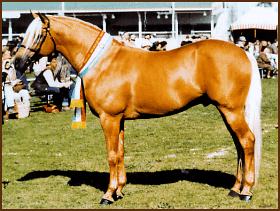
COMMON HORSE BREEDS
| PALOMINO
Origin: |
 Photo supplied by The Australian Palomino Horsebreeders Association Inc. - Victoria © |
History:
The term Palomino does not refer to a specific breed of horses but to a
type of color. The Palomino colouring is evident in a number of breeds. There are various
theories where the name Palomino comes from, one suggests that it comes from Juan de
Palomino who received a golden colored horse from Cortes.
The origin of the Palomino is not clear as golden colored horses are found all over the
world. Works of art dating back many centuries depict such horses in Asia, Japan and
several European countries. The Spanish Queen Isabella encouraged the breeding of golden
horses, as a result in Spain they are often referred to as Isabellas. In North America
Palominos were imported by the Spanish Conquistadores. This type of coloring is believed
to come from Arabian horses.
In Britain breeds with Palomino coloring include the Welsh Pony and Cob and in the United
States they include Morgans, Quarter Horses, American Saddlebreds, Arabians and Tennessee
Walking Horses.
Characteristics:
variable conformation
Height: 14 to 17hh, according to the register of Palomino Horse Breeders of America
Personality: kind
Requirements for registration with the Palomino
Horse Breeder's of America:
| - | refined head and bones |
| - | general conformation of the breeds recognised by the PHBA |
| - | suitable to carry English or Western equipment |
| - | must not show draught horse or pony characteristics |
| Color: |
|
| - body color of a newly minted gold coin
with variations from light to dark - skin color of grey, black, brown or motley without underlying pink skin or spots except on face and legs - back, brown or hazel eyes - white mane and tail with no more than 15% dark, chestnut or sorrel hair - Zebra and dorsal stripes are not permitted |
|
There is a lot of uncertainty involved in breeding for the Palomino color. When two Palomino horses mate there is a 50% chance that the foal will have the color of the parents and a 25% chance that it will be bright chestnut and also a 25% chance that it will be cremello. If a Palomino is crossed with a sorrel colored horse the chances are still only 50% and the color may be too poor to be registered with most Palomino societies.
Today:
Palominos are good all-round riding horses. They are well suited for trail
riding, cutting horse events and working on ranches. Palominos can also be seen in
the show ring and on the racetrack.
![]()